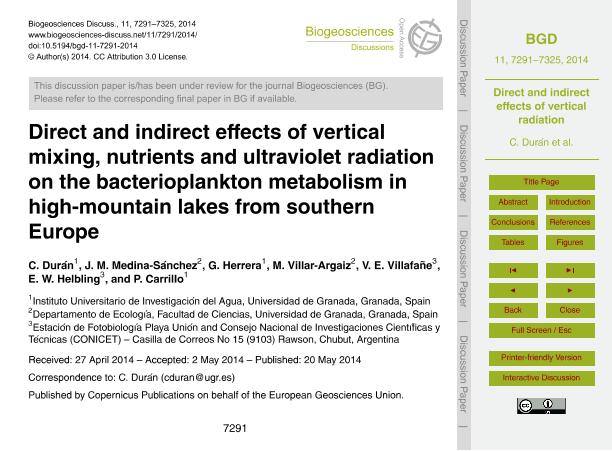Artículo
Direct and indirect effects of vertical mixing, nutrients and ultraviolet radiation on the bacterioplankton metabolism in high-mountain lakes from southern Europe
Durán, C.; Medina Sánchez, J. M.; Herrera, G.; Villar Argaiz , M.; Villafañe, Virginia Estela ; Helbling, Eduardo Walter
; Helbling, Eduardo Walter ; Carrillo, P.
; Carrillo, P.
 ; Helbling, Eduardo Walter
; Helbling, Eduardo Walter ; Carrillo, P.
; Carrillo, P.
Fecha de publicación:
2014
Editorial:
Copernicus Publications
Revista:
Biogeosciences Discuss
ISSN:
1810-6277
Idioma:
Inglés
Tipo de recurso:
Artículo publicado
Clasificación temática:
Resumen
As a consequence of global change, modifications in the interaction among abiotic stressors on aquatic ecosystems have been predicted. Among other factors, UVR transparency, nutrient inputs and shallower epilimnetic layers could alter the trophic links in the microbial food web. Currently, there are some evidences of higher sensitiveness of aquatic microbial organisms to UVR in opaque lakes. Our aim was to assess the interactive direct and indirect effects of UVR (through the excretion of organic carbon – EOC – by algae), mixing regime and nutrient input on bacterial metabolism. We performed in situ short-term experiments under the following treatments: full sunlight (UVR + PAR, >280 nm) vs. UVR exclusion (PAR only, >400 nm); ambient vs. nutrient addition (phosphorus (P; 30 μg PL−1) and nitrogen (N; up to final N : P molar ratio of 31)); and static vs. mixed regime. The experiments were conducted in three high-mountain lakes of Spain: Enol [LE], Las Yeguas [LY] and La Caldera [LC] which had contrasting UVR transparency characteristics (opaque (LE) vs. clear lakes (LY and LC)). Under ambient nutrient conditions and static regimes, UVR exerted a stimulatory effect on heterotrophic bacterial production (HBP) in the opaque lake but not in the clear ones. Under UVR, vertical mixing and nutrient addition HBP values were lower than under the static and ambient nutrient conditions, and the stimulatory effect that UVR exerted on HBP in the opaque lake disappeared. By contrast, vertical mixing and nutrient addition increased HBP values in the clear lakes, highlighting for a photoinhibitory effect of UVR on HBP. Mixed regime and nutrient addition resulted in negative effects of UVR on HBP more in the opaque than in the clear lakes. Moreover, in the opaque lake, bacterial respiration (BR) increased and EOC did not support the bacterial carbon demand (BCD). In contrast, bacterial metabolic costs did not increase in the clear lakes and the increased nutrient availability even led to higher HBP. Consequently, EOC satisfied BCD in the clear lakes, particularly in the clearest one [LC]. Our results suggest that the higher vulnerability of bacteria to the damaging effects of UVR may be particularly accentuated in the opaque lakes and further recognizes the relevance of light exposure history and biotic interactions on bacterioplankton metabolism when coping with fluctuating radiation and nutrient inputs.
Palabras clave:
Bacterioplankton
Archivos asociados
Licencia
Identificadores
Colecciones
Articulos(CCT-CENPAT)
Articulos de CTRO.CIENTIFICO TECNOL.CONICET - CENPAT
Articulos de CTRO.CIENTIFICO TECNOL.CONICET - CENPAT
Citación
Durán, C.; Medina Sánchez, J. M.; Herrera, G.; Villar Argaiz , M.; Villafañe, Virginia Estela; et al.; Direct and indirect effects of vertical mixing, nutrients and ultraviolet radiation on the bacterioplankton metabolism in high-mountain lakes from southern Europe; Copernicus Publications; Biogeosciences Discuss; 11; -1-2014; 7291-7325
Compartir
Altmétricas



